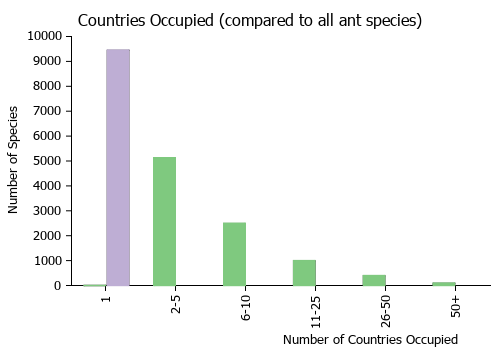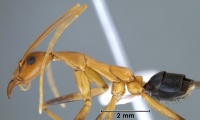Leptomyrmex rufipes
| Leptomyrmex rufipes | |
|---|---|

| |
| Leptomyrmex rufipes | |
| Scientific classification | |
| Kingdom: | Animalia |
| Phylum: | Arthropoda |
| Class: | Insecta |
| Order: | Hymenoptera |
| Family: | Formicidae |
| Subfamily: | Dolichoderinae |
| Tribe: | Leptomyrmecini |
| Genus: | Leptomyrmex |
| Species: | L. rufipes |
| Binomial name | |
| Leptomyrmex rufipes Emery, 1895 | |
| Synonyms | |
| |
L. rufipes has been recorded in rainforest, mesophyll vine forest, Eucalyptus open forest, and wet and dry sclerophyll. Nests occur in cavities in live trees, on the ground at tree bases, in large open mounds, in or under logs, and under rocks.
| At a Glance | • Replete Workers |
Photo Gallery
Identification
Workers are slender and long-limbed. The black gaster and (usually) dark distal portions of the femora contrast with the otherwise pale orange head, mesosoma and appendages. In body size and coloration, this species resembles Leptomyrmex cnemidatus and Leptomyrmex varians. The pale tibiae of L. rufipes easily distinguish it from the others, which have dark tibiae. The necklike constriction at the posterior margin of the head is also distinctive - this margin is broadly rounded in L. cnemidatus. In L. varians the head narrows beyond the eyes, but does not project into a dorsoventrally compressed ‘neck’. Head shape is sufficient to distinguish L. rufipes from all congeners with the exception of its sister species, Leptomyrmex ruficeps and Leptomyrmex rothneyi. These species can be separated from L. rufipes based on color patterns and geographic range: L. ruficeps is black with a red head and restricted to the Wet Tropics and L. rothneyi is a mottled, dark species confined to the southeast corner of Queensland. (Lucky and Ward 2010)
Identification Keys including this Taxon
Distribution
This species occupies the widest geographic range of all the Leptomyrmex species, extending from the base of the Cape York Peninsula in north Queensland to the northern border of New South Wales. (Lucky and Ward 2010)
Latitudinal Distribution Pattern
Latitudinal Range: -19.00085923° to -28.25413844°.
| North Temperate |
North Subtropical |
Tropical | South Subtropical |
South Temperate |
- Source: AntMaps
Distribution based on Regional Taxon Lists
Australasian Region: Australia (type locality).
Distribution based on AntMaps
Distribution based on AntWeb specimens
Check data from AntWeb
Countries Occupied
| Number of countries occupied by this species based on AntWiki Regional Taxon Lists. In general, fewer countries occupied indicates a narrower range, while more countries indicates a more widespread species. |

|
Estimated Abundance
| Relative abundance based on number of AntMaps records per species (this species within the purple bar). Fewer records (to the left) indicates a less abundant/encountered species while more records (to the right) indicates more abundant/encountered species. |

|
Elevation Range
| Species | Elevation (m asl) | |||||
|---|---|---|---|---|---|---|
| 200 | 400 | 600 | 800 | 1000 | 1200 | |
| Leptomyrmex rufipes | 20-30 | 30-40 | 20-30 | |||
| Shading indicates the bands of elevation where species was recorded. Numbers are the percentage of total samples containing this species. | ||||||
Biology
|
Castes
Phylogeny
| Leptomyrmex |
| ||||||||||||||||||||||||||||||||||||||||||||||||||||||||||||||||||||||||||||||||||||||||||||||||||||||||||||||||||||||||||||||||||||||||||
Based on Barden et al., 2017. Note only selected Leptomyrmex species are included.
Nomenclature
The following information is derived from Barry Bolton's Online Catalogue of the Ants of the World.
- rufipes. Leptomyrmex varians var. rufipes Emery, 1895g: 352 (w.) AUSTRALIA. Lucky & Ward, 2010: 52 (ergatoid q., m.). Subspecies of varians: Wheeler, W.M. 1934c: 104. Raised to species: Lucky & Ward, 2010: 50. Senior synonym of quadricolor: Lucky & Ward, 2010: 50.
- quadricolor. Leptomyrmex varians subsp. quadricolor Wheeler, W.M. 1934c: 104 (w.) AUSTRALIA. Junior synonym of rufipes: Lucky & Ward, 2010: 50.
Type Material
- Leptomyrmex varians rufipes: Syntype, worker(s), Laidley (as Laidely) and Brisbane, Queensland, Australia, Museo Civico di Storia Naturale, Genoa.
- Leptomyrmex varians quadricolor: Syntype, 2 workers, Lankelly Creek, McIlwraith (as McIlthwaite) Range, Cape York Peninsula, Queensland, Australia, The Natural History Museum.
- Leptomyrmex varians quadricolor: Syntype, 16 workers, Lankelly Creek, McIlwraith (as McIlthwaite) Range, Cape York Peninsula, Queensland, Australia, Museum of Comparative Zoology.
- Leptomyrmex varians quadricolor: Syntype, 2 workers, Lankelly Creek, McIlwraith (as McIlthwaite) Range, Cape York Peninsula, Queensland, Australia, Museum Victoria, Melbourne.
- Leptomyrmex varians quadricolor: Syntype, 3 workers, Lankelly Creek, McIlwraith (as McIlthwaite) Range, Cape York Peninsula, Queensland, Australia, National Museum of Natural History.
Unless otherwise noted the text for the remainder of this section is reported from the publication that includes the original description.
Description
Worker
Lucky and Ward (2010) – measurements (n = 11) HL 1.94 –2.43, HW 1.08–1.39, MFC 0.24–0.34, IOD 0.59–0.78, SL 3.62–4.35, EL 0.40–0.46, WL 3.61–4.52, PW 0.96–1.26, DPW 0.37–0.51, HTL 4.52–5.67, HTWmin 0.14–0.19, HTWmax 0.16–0.25, CI 0.54–0.64, SI 2.75–3.35, OI 0.11–0.13, HTC 0.61–0.88.
Medium sized species (HL 1.94 –2.43, HW 1.08–1.39) with head long and slender, excluding mandibles head less than twice as long as broad (CI 0.54–0.64). Head widest at eye level, sides of head subparallel, narrowing anteriorly, genae slightly concave. Posterior to eyes, head narrowing abruptly to dorsoventrally flattened neck-like constriction. Masticatory margin of mandible with 15 to 20 teeth and denticles interspersed. Anterior clypeal margin flat to weakly concave. Eyes positioned approximately at midline of head, eyes small, convex, hairless, not reaching lateral margins. Antennae long and slender, not compressed, scapes surpassing posterior margin of head by 2/3 their length.
Pronotum slender, elongate. Propodeum short, dorsal face of propodeum flat or with transverse impression at anterior end, declivitous face short and convex, propodeal angle very rounded. Petiole triangular in profile, posterior face with slight median longitudinal impression, dorsum rounded, posterior face longer than anterior face. Ventral surface of petiole nearly flat. Gaster elongate-elliptical. Legs very long and slender, not compressed.
Surface very finely shagreened and somewhat shining throughout. Mandibles with a coarse row of punctures along margin. Pubescence pale, sparse. Hairs minimal, confined to clypeus, venter and gaster, 0–5 brown bristles on hind tibiae. Body rufotestaceous with black gaster. Head and antennae rufotestaceous. Femora pale at base and sometimes throughout, but often the distal 1/4 to 3/4 of the femur is black. Tibiae and tarsi yellow, gaster black with the anterior portion of first segment and anal orifice pale yellow.
Queen
Lucky and Ward (2010) – Head broader than in worker. Three ocelli deeply set into head in triangular formation, the anteriormost one largest, the posterior two smaller. Pronotum, mesonotum and propodeum more voluminous than in worker. Dorsal face of propodeum convex, lacking transverse impression. Petiole broader than high, with flat dorsal face. Gaster globose, larger than in worker. Scapes, femora and tibiae robust.
Queen coloration similar to that of worker, but with only the first one or two segments of the gaster black, and the remainder rufotestaceous.
Male
Lucky and Ward (2010) - measurements (n = 11) HL 1.57–1.92, HW 1.14–1.37, SL 0.38–0.50, EL 0.59–0.71, HTL 4.61–4.95, CI 0.68–0.77, SI 0.33–0.37, SI2 0.65–0.78.
References
- Burwell, C.J., Nakamura, A. 2020. Rainforest ants (Hymenoptera: Formicidae) along an elevational gradient at Eungella in the Clarke Range, Central Queensland coast, Australia. Proceedings of the Royal Society of Queensland 125: 43-63.
- Lucky, A. 2011. Molecular phylogeny and biogeography of the spider ants, genus Leptomyrmex Mayr (Hymenoptera: Formicidae). Molecular Phylogenetics and Evolution 59: 281-292. doi:10.1016/j.ympev.2011.03.004
- Lucky, A. & Ward, P.S. 2010. Taxonomic revision of the ant genus Leptomyrmex Mayr. Zootaxa 2688: 1-67. PDF
References based on Global Ant Biodiversity Informatics
- Burwell C.J., and A. Nakamura. 2011. Distribution of ant speces along an altitudinal transect in continuous rainforest in subtropical Queensland, Australia. Memoirs of the Queensland Museum -Nature 55(2): 391-411.
- Lucky A., and P. S. Ward. 2010. Taxonomic revision of the ant genus Leptomyrmex Mayr (Hymenoptera: Formicidae). Zootaxa 2688: 1-67.
- Taylor R. W. 1987. A checklist of the ants of Australia, New Caledonia and New Zealand (Hymenoptera: Formicidae). CSIRO (Commonwealth Scientific and Industrial Research Organization) Division of Entomology Report 41: 1-92.
- Wheeler W. M. 1915. The Australian honey-ants of the genus Leptomyrmex Mayr. Proceedings of the American Academy of Arts and Sciences 51: 255-286.



